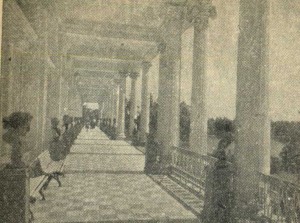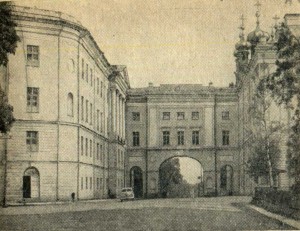This town — the treasure-house of Russian culture and the birthplace of Pushkin’s poetic genius — is dear to the hearts of the Russianpeople. Not only the modest four-storey building of the Lycee where the young poet spent his school years but the whole of Tsarskoye Selo is closely connected with the creative life of Pushkin.
The town of Pushkin was founded at the beginning of the 18th century, when royal residences and country houses of the nobility were being erected in the vicinity of the newly-built capital. First there was built a small country-house called Saari Mois (the Finnish for uplands) changed by Russians to Sadrskaya Mtza (a grange). In 1710 the lands of this estate were given by Peter I to his wife Yekaterina Alekseyevna. After that the place was called Saarskoye Selo, and after 1725 —Tsarskoye Selo.
One of the most remarkable periods in the history of Tsarskoye Selo was the 1740—1750’s. Thousands of rabotniye lyudi (workmen), serfs, soldiers and sailors worked on extending and laying out the parks. It was by the toil of these people that the Grand (Yekaterininsky) Palace was erected at that time. The outstanding Russian sculptors A. V. Kvasov and S. I. Chevakinsky worked out the design of the palace. It fell to the greatest architect of that time V. V. Rastrelli who highly valued and followed the best traditions of Russian architecture, to complete the work. A superb building was created, astonishing the architect’s contemporaries with its beauty and grandeur. The palace, barbarously destroyed by the German fascists in the war years, has been restored by the persistent and painstaking toil of Russianpeople. The complex decoration of the main facade is almost completed and the interior is also under reconstruction. Several rooms, the Predkhornaya, the Green Dining-Hall and the Blue Drawing roojii among them, have recently been opened to visitors. An exhibition describing the history of the development of the palace and park is displayed in certain halls of the palace.
In the middle and the second half of the 18th century the park was extended according to the design of Rastrelli who worked in co-operation with S. I. Chevakinsky and V. I. Neyelov. Some fanciful structures appeared in the park including one of the most notable buildings in Tsarskoye Selo, the Hermitage.
During the last three decades of the 18th century a talented Pleiad of architects, C. Cameron, V. I. and I. V. Neyelovs, A. Rinaldi and Y. M. Felten went on improving the artistic layout of the parks. The Alexander Palace and the Lycee, the Agate Rooms and Cameron’s Gallery, the Upper Bath and Lower Bath Pavilions, as well as the Concert Hall, were erected at that period. One is struck by the architecture of the Alexander Palace (1792—1796), one of the finest creations of the outstanding architect D. Quarenghi.
In the-1830’s bronze statues of two Youths were set up in front of the palace standing out clearly against the light-coloured colonnade. The statues were cast from the originals made by the well-khown Russian sculptors N. I. Pimenov and A. V. Loganovsky. Youth Playing Knucklebones that stands to “the left of the palace is by N. I. Pimenov. Youth Playing Svaika — an old Russian folk game — that is to the right of the palace is by A. V. Loganovsky.
After a great deal of reconstruction work was completed, the exhibition Pushkin in Russianand foreign culture was opened in Cameron’s Gallery. This exhibition is displayed in ten halls and in the main passage of the ground floor.
Many other structures in Tsarskoye Selo built in the later years of the 18th century imitated in a rather stvlized wav Chinese architecture. Those are: the Chinese Theatre in the Alexander Park, the Skriptichaya Besedka (The Squeaky Summer-house) in the western part of the Yekaterin’nsky Park, the group of houses composing the Chinese Village and the Grand Caprice.
At the same time a number of monuments to Russian m’Htary glory — later sung by Pushkin in his inspired poetry — were erected in Tsarskoye Selo. An obelisk in memory of the Russian victory over the Turks on the river Kagul on the 21st of July, 1770 was unveiled in the upoer part of the Yekaterininsky Park. The Cestne Column was set up at the Large Pond in honour of the victories of the Russian Navy in the Russo-Turkish War.
Further improvements and building at Tsarskoye Selo were closelv connected with the names of such gifted architects as V. P. Stasov and P. V. Neyelov. At the beginning of the 19th century V. P. Stasov erected the Triumphal Gate in honour of the Russian victory in the Patriotic War of 1812; the Vecherny Zal (Evening Hall) near the Yekaterininsky Palace .was bu’lt to the design of P. V. Neyelov; the Granite Terrace was designed by L. I. Ruska. The sculptor P. P. Sokolov created h;s famous bronze statue The Milkmaid. (Otherwise called the Girl with a Pitcher).
The main buildings in the town were erected to the designs of V. P. Stasov and his assistants V. I. Geste, A. M. Gornostayev and S. L. Shustov. In 1811 V. P. Stasov reconstructed the building near the Yekaterininsky Palace, and a school for the nobility called the Lycee was opened there.
Among the first pupils of the Lycee were A. S. Pushkin and his friends I. I. Pushchin and V. K. Kiichelbaker who afterwards joined the Decembrists. Here, at the Lycee, A. S. Pushkin studied from 1811 to 1817.
On May 28, 1831 Pushkin and his w’fe came to Tsarskoye Selo and settled in a small cottage belonging to the widow Anna Kitayeva. The cottage has been preserved and on December 6, 1958 a memorial museum was opened here (Pushkin-skaya Ulitsa, No. 2). The exhibition of the museum is devoted to Pushkin’s life and his creative work in the summer of 1831. It was in this cottage that the great writer created his best poems, including the patriotic Borodinsky Anniversary and To the Slanderers of Russia. It was here, too, that he wrote his famous Tale of’the Tsor Snltan and Onegin’s Letter to Tatydna, thus completing almost eight years’ work at his superb ‘novel in verse’, Eugene Onegin. At Tsarskoye Selo Pushkin also began his. prose works Roslavlev and A Romance at a Caucasian Catering-Place. In 1900 a monument to young Pushkin designed by the sculptor R. R. Bach was set up in the Lycee garden.
During the festivities commemorating the 150th anniversary of the poet’s birth, a memorial museum was opened in the restored building of the Lycee. Its exhibition is devoted to Pushkin’s school days and his creative work. The museum enjoys great popularity with Saint Petersburgers and the tourists who come here from all parts of the country.
The construction of the first railway line in Russia (1836), which connected the town with Pavlovsk, encouraged the further development of Tsarskoye Selo in the 19th century. This railway was primarily intended for the use of the tsar’s family and the court. Soon a block of houses sprang up near the railway station and later on the Petersburg nobility began to build countrv-houses along the Pavlovsk Road. In 1887 a model water supply, a sewage system and even an electric power-station were put into action at Tsarskoye Selo. The town was one of the first in Europe to be lit entirely by electricity.
There are a good many memorial places which remind one of the outstanding people who happened to live in or visit the town.
In the spring and autumn of 1891, as well as in 1893—1894, V. I. Lenin used to ccme here to see A. A. Shukht, a friend of the Ulyanovs. Maria Aleksandrovna, Vladimir Ilyich’s mother, came on a visit here, too. On April 2, 1895 Vladimir Ilyich came to Tsarskoye Selo to see the Marxist M. A. Silvin who lived in Konyushennaya Street (now called No. 11, First of May Street; the house is no longer in existence). A conference of the members of the Petersburg Social-Democrat group. with N. K. Krupskaya.A. A. Yakubova, V. V. Starkov, P. K- Zaporozhets, M. A. Silvin and others participating, was held at this house. The conference was directed by Lenin. The people present discussed their plans and distributed the duties among the members of the organization. At this time it became obvious that the police were watching Vladimir Ilyich very closely. That is why, as N. K. Krupskaya writes in her memoirs, ‘almost all day long we discussed the problem what contacts were to be preserved. Vladimir Ilyich taught us ciphering. We ciphered nearly half a book’.
In May 1900, on his way from Pskov to Petersburg V. I. Lenin stayed for a short time at Tsarskoye Selo where he was shadowed by the police. On “April 22, 1960, in the centre of the garden, a monument to V. I. Lenin, the great leader of the proletariat, was inaugurated to commemorate the 90th anniversary of his birth.
The monument was created by the sculptor Z. I. Azgur and the architect E. A. Levinson.
At different times such writers as N. M. Karamzin, M. Y. Lermontov, F. I.Tyutchev, D. N. Mamin-Sibiryak, A. A. Blok, A. N. Tolstoi, S. Y. Marshak, K. A. Fedin, V. Y. Shishkov and others lived and worked at Tsarskoye Selo.
Among the memorials of the town is the monument to Ernst Thalmann, the leader of the German proletariat. The monument (by the sculptor V. Arnold) was cast by the metallurgists of Eisleben. It is a gift of the workers of the German Democratic Republic to the people of the town of Pushkin. The monument stands in the Russian Boulevard.
The Lycee, where the young Pushkin studied.







